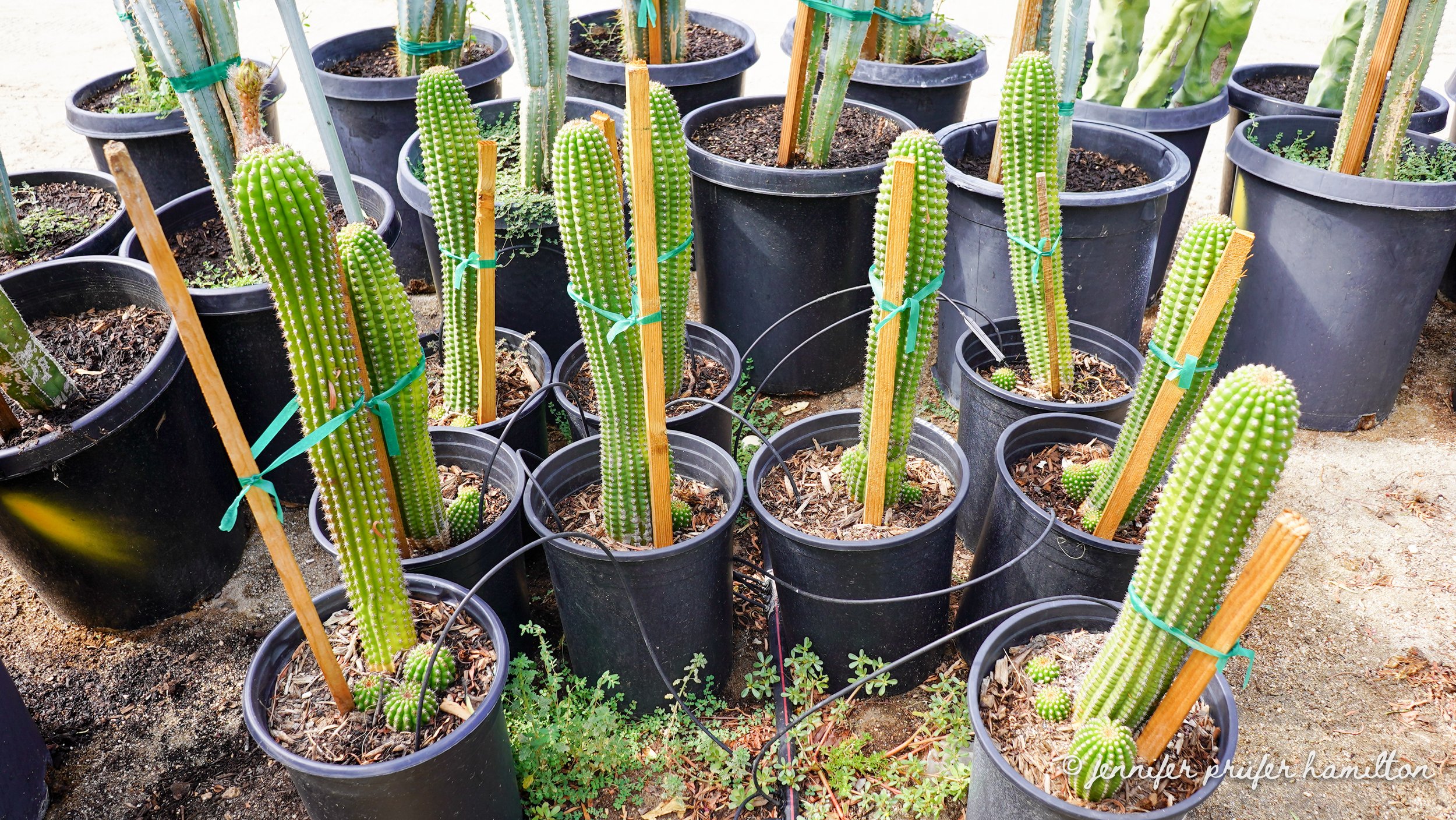Indian Comb Cactus
Indian Comb Cactus is a columnar cactus with a wonderful geometric texture. The grooves and ridges give it a pronounced texture that stands out, especially at golden hour or at night with landscaping light.
When it blooms, the large and showy flowers will captivate your attention. They have a sweet smell and captivate the attention of night pollinators as well.
Botanical name: Trichocereus brevispinulosus
Other names: Echinopsis brevispinulosus, Indian comb
Indian Comb Cactus for sale at our nursery
TABLE OF CONTENTS
Indian Comb Cactus Appearance
Indian Comb Cactus is a columnar cactus that grows tall and straight. May grow arms from the side. Grows offsets near the base of the plant.
Grows to 5-8 feet tall outdoors in Southern California.
Medium green stems.
The vertical ridges and areoles are very pronounced, creating a distinctive bumpy texture. Numerous, short, prickly spines.
Very showy and large white flowers when in bloom. They are nocturnal and fragrant.
Followed by dark-colored fruits.
Indian Comb Cactus Landscaping Tips
Indian Comb Cactus is somewhat rare. Great collector’s item for a cactus or succulent garden.
Adds interesting texture to the garden with its geometric lines.
Grows a generous number of offsets for propagating and sharing.
An easy, beginner-friendly cactus that can handle a wide range of temperatures, water, and pests.
Beautiful, showy white flowers are captivating. A great plant to keep in a moon garden.
Somewhat toxic to humans and pets if ingested.
Indian Comb Cactus Origin
The exact origins of Indian Comb Cactus are disputed. Many believe that it is a hybrid from San Pedro Cactus, which is from South America.
Indian Comb Cactus Care
Soil: Loose, well-draining soil that is somewhat fertile.
Temperature: Can withstand temperatures down to 25 degrees for a short period of time.
Water: Occasional, deep watering. Allow the soil to completely dry out between waterings. Either use a moisture meter or stick your finger through the soil to gauge the moisture level. It’s better to err on the side of underwatering than overwatering.
Sun: Full sun. Partial shade in areas that experience extreme heat.
Indian Comb Cactus Problems
Pests: Fungal diseases from root rot, dry rot, and harsh weather conditions. Mostly pest-resistant, but may attract spider mites. Control the infestation as soon as it’s discovered. Some options are horticultural oil applied several days apart as well as insecticidal soap combined with hydrogen peroxide.
Whenever using any kind of pesticide, be aware that it can damage the plant if the temperatures are in the 80s or above.
Signs of overwatering: Drooping, squishy texture (especially at the bottom of the cactus)
Signs of too little water: Shriveling, drying skin
Signs of too much sun: Burning, scarring, yellowing
Signs of too little sun: Etiolation, discoloring
Indian Comb Cactus Propagation
The easiest way to propagate the cactus is by transplanting the offsets that can grow from the base.
FAQ
How much does Indian Comb Cactus cost?
At our nursery, Indian Comb Cactus costs $15 for a 1-gallon container, $45 for a 5-gallon container, and $150 for a 15-gallon container.
Prices are subject to change. Please contact us for the most up-to-date pricing information. We may have larger sizes available. We provide installation services locally at a separate cost.
Is the indian comb cactus a rare cactus?
Yes, it is somewhat rare and not widely offered in most stores and plant nurseries.
Can I grow indian comb cactus indoors?
Yes, and it’s encouraged if you experience winters that get below 25 degrees Fahrenheit. Ensure the cactus gets lots of bright sunlight so that it is healthy and doesn’t bend towards the sunlight.
SUMMARY
| SIZE (H X W) | 5-8 feet |
|---|---|
| FLOWER COLOR | White |
| FLOWER SEASON | Spring |
| EXPOSURE | Full Sun to Partial Shade |
| WATER | Low |
| GROWTH RATE | Moderate |
| HARDINESS | 25º F, USDA Zone 9 |
| PRUNING | None |
